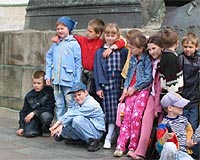| . |  |
. |
Basel, Switzerland (AFP) July 28, 2009 The swine flu virus has set the laboratories and factories of Swiss pharmaceutical giants working all-out in the difficult search for vaccines and the race for other treatments. Novartis, among the laboratories charged with developing a vaccine against the flu, says governments are queuing up with advance orders, while Roche says growing demand for its anti-viral drug Tamiflu has boosted profits. Novartis is set to start clinical trials this month and hopes to make the vaccine available to the public in the northern hemisphere's autumn. A spokesman for the group said it has seen "good progress" in developing a vaccine against the new strain of the A(H1N1) flu virus, but warned that producing it is turning out to be more difficult than expected. Novartis has "started the production of this antigen on a big scale in all its sites in Europe" but "the yield has been weaker than expected," meaning it will take longer to produce its target volumes of vaccines, he said. At the moment, this target is set at 150 million doses of the vaccine a year, but Novartis said the number cannot be confirmed until after clinical trials. These will monitor how trial patients respond to the vaccine and whether a single injection is sufficient, according to the World Health Organisation (WHO). Others working on a vaccine include the British company GlaxoSmithKline (GSK) and the US firm Baxter. The WHO said vaccine manufacturers are all "continuing to improve yields", which are currently at 25 to 50 percent of the typical yields of seasonal flu vaccines. "Novartis has received several orders of the H1N1 vaccine during its negotiations with over 35 governments," said the group, adding that the American government has signed two contracts totalling 979 million dollars. Other orders have been made by France, the Netherlands and Switzerland, said the spokesman, without revealing the value of the contracts. Governments are also ramping up their anti-viral stocks amid the pandemic. Another Swiss pharma giant, Roche, has profited lately from unexpected demand for its drug Tamiflu. Tamiflu is one of two medications recommended by the WHO to treat infections of A(H1N1) flu. The other is Relenza, made by the British drugs firm GlaxoSmithKline. Sales of Tamiflu soared to one billion Swiss francs (656 million euros, 937 million dollars) in the first half of the year, with a jump of 1,510 percent in Japan and 869 percent in Europe. Roche expects to rake in the same amount in the second half of the year, bringing total sales of Tamiflu in 2009 to two billion francs, the group's chief executive Severin Schwan forecast. The group is also increasing production of the drug to reach an annual capacity of 110 million treatment courses by October, a spokeswoman said. If necessary, the group can ramp up production across its 19 factories to its maximum capacity of 400 million treatments a year by 2010, a huge increase after it produced only 300 million over the past five years. The group, whose net profit shot up 11 percent to 5.2 billion francs in the first half of 2009, has promised not to show favouritism in the distribution of the medication. "First come, first served," said the head of its pharmaceutical division William Burns, stressing that big powerful nations would not be privileged at the expense of smaller countries. Share This Article With Planet Earth
Related Links Epidemics on Earth - Bird Flu, HIV/AIDS, Ebola
 Russia bans school trips to Britain: reports
Russia bans school trips to Britain: reportsMoscow (AFP) July 27, 2009 Russia's top health official on Monday banned the practice of sending groups of school children to Britain to prevent the spread of swine flu, Russian news agencies reported. "England is the country most exposed [to the A(H1N1) virus] in Europe," ITAR-TASS quoted public health chief Gennady Onishchenko as saying. "Therefore I have signed a directive banning all trips by children to England ... read more |
|
| The content herein, unless otherwise known to be public domain, are Copyright 1995-2009 - SpaceDaily. AFP and UPI Wire Stories are copyright Agence France-Presse and United Press International. ESA Portal Reports are copyright European Space Agency. All NASA sourced material is public domain. Additional copyrights may apply in whole or part to other bona fide parties. Advertising does not imply endorsement,agreement or approval of any opinions, statements or information provided by SpaceDaily on any Web page published or hosted by SpaceDaily. Privacy Statement |